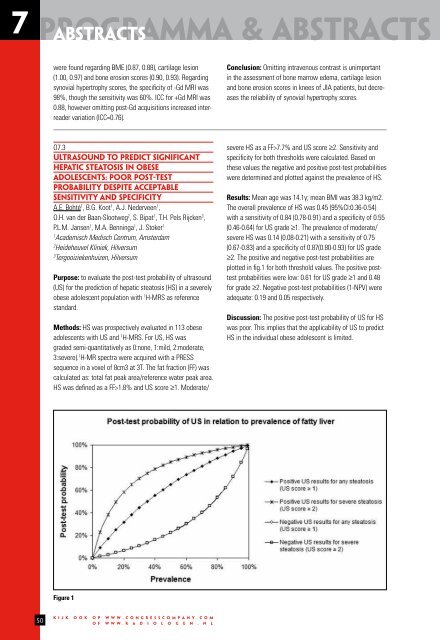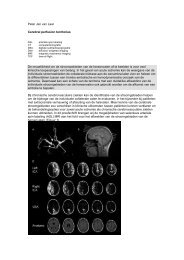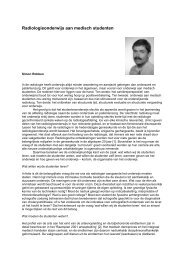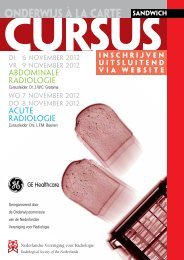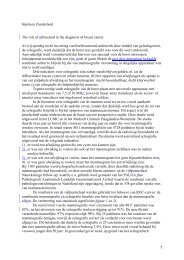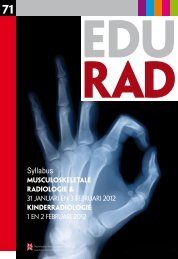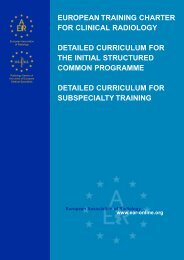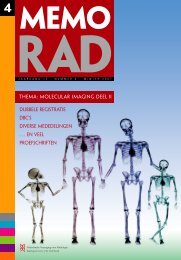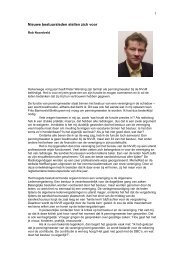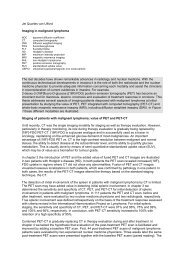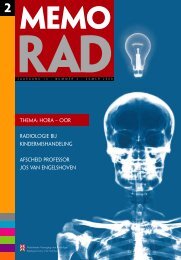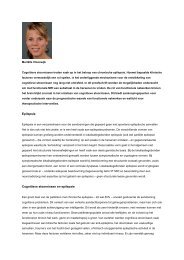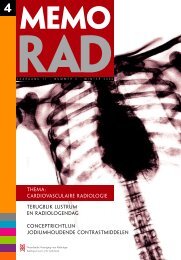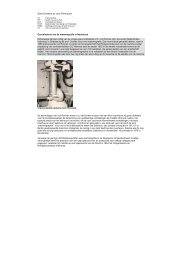programma & abstracts - Nederlandse Vereniging voor Radiologie
programma & abstracts - Nederlandse Vereniging voor Radiologie
programma & abstracts - Nederlandse Vereniging voor Radiologie
Create successful ePaper yourself
Turn your PDF publications into a flip-book with our unique Google optimized e-Paper software.
7<br />
<strong>programma</strong> <strong>abstracts</strong> & <strong>abstracts</strong><br />
were found regarding BME (0.87, 0.88), cartilage lesion<br />
(1.00, 0.97) and bone erosion scores (0.90, 0.93). Regarding<br />
synovial hypertrophy scores, the specificity of -Gd MRI was<br />
98%, though the sensitivity was 60%. ICC for +Gd MRI was<br />
0.88, however omitting post-Gd acquisitions increased interreader<br />
variation (ICC=0.76).<br />
Conclusion: Omitting intravenous contrast is unimportant<br />
in the assessment of bone marrow edema, cartilage lesion<br />
and bone erosion scores in knees of JIA patients, but decreases<br />
the reliability of synovial hypertrophy scores.<br />
O7.3<br />
ULTRASOUND TO PREDICT SIGNIFICANT<br />
HEPATIC STEATOSIS IN OBESE<br />
ADOLESCENTS: POOR POST-TEST<br />
PROBABILITY DESPITE ACCEPTABLE<br />
SENSITIVITY AND SPECIFICITY<br />
A.E. Bohté 1 , B.G. Koot 1 , A.J. Nederveen 1 ,<br />
O.H. van der Baan-Slootweg 2 , S. Bipat 1 , T.H. Pels Rijcken 3 ,<br />
P.L.M. Jansen 1 , M.A. Benninga 1 , J. Stoker 1<br />
1<br />
Academisch Medisch Centrum, Amsterdam<br />
2<br />
Heideheuvel Kliniek, Hilversum<br />
3<br />
Tergooiziekenhuizen, Hilversum<br />
Purpose: to evaluate the post-test probability of ultrasound<br />
(US) for the prediction of hepatic steatosis (HS) in a severely<br />
obese adolescent population with 1 H-MRS as reference<br />
standard.<br />
Methods: HS was prospectively evaluated in 113 obese<br />
adolescents with US and 1 H-MRS. For US, HS was<br />
graded semi-quantitatively as 0:none, 1:mild, 2:moderate,<br />
3:severe). 1 H-MR spectra were acquired with a PRESS<br />
sequence in a voxel of 8cm3 at 3T. The fat fraction (FF) was<br />
calculated as: total fat peak area/reference water peak area.<br />
HS was defined as a FF>1.8% and US score ≥1. Moderate/<br />
severe HS as a FF>7.7% and US score ≥2. Sensitivity and<br />
specificity for both thresholds were calculated. Based on<br />
these values the negative and positive post-test probabilities<br />
were determined and plotted against the prevalence of HS.<br />
Results: Mean age was 14.1y; mean BMI was 38.3 kg/m2.<br />
The overall prevalence of HS was 0.45 (95%CI:0.36-0.54)<br />
with a sensitivity of 0.84 (0.78-0.91) and a specificity of 0.55<br />
(0.46-0.64) for US grade ≥1. The prevalence of moderate/<br />
severe HS was 0.14 (0.08-0.21) with a sensitivity of 0.75<br />
(0.67-0.83) and a specificity of 0.87(0.80-0.93) for US grade<br />
≥2. The positive and negative post-test probabilities are<br />
plotted in fig.1 for both threshold values. The positive posttest<br />
probabilities were low: 0.61 for US grade ≥1 and 0.48<br />
for grade ≥2. Negative post-test probabilities (1-NPV) were<br />
adequate: 0.19 and 0.05 respectively.<br />
Discussion: The positive post-test probability of US for HS<br />
was poor. This implies that the applicability of US to predict<br />
HS in the individual obese adolescent is limited.<br />
Figure 1<br />
50<br />
k i j k o o k o p w w w . c o n g r e s s c o m p a n y . c o m<br />
o f w w w . r a d i o l o g e n . n l


